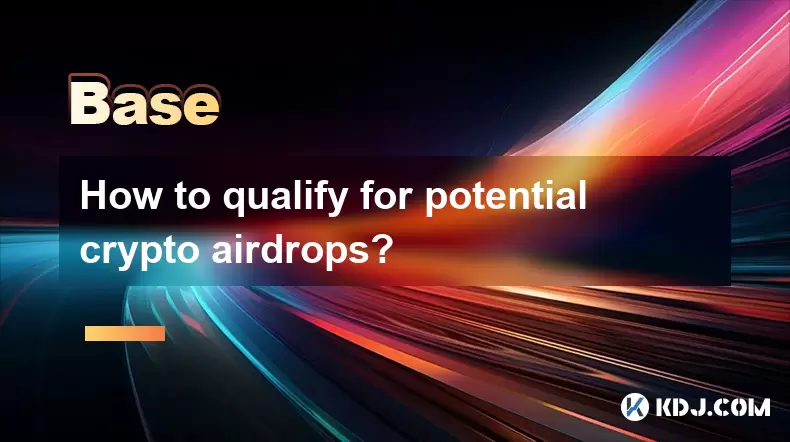-
 Bitcoin
Bitcoin $116400
-1.48% -
 Ethereum
Ethereum $3722
3.15% -
 XRP
XRP $3.129
1.48% -
 Tether USDt
Tether USDt $1.000
-0.03% -
 BNB
BNB $768.9
1.23% -
 Solana
Solana $180.8
-1.72% -
 USDC
USDC $0.0000
0.00% -
 Dogecoin
Dogecoin $0.2317
-0.63% -
 TRON
TRON $0.3155
2.50% -
 Cardano
Cardano $0.8087
1.89% -
 Hyperliquid
Hyperliquid $43.06
2.54% -
 Stellar
Stellar $0.4234
1.56% -
 Sui
Sui $3.736
2.20% -
 Chainlink
Chainlink $18.09
2.28% -
 Bitcoin Cash
Bitcoin Cash $560.5
7.42% -
 Hedera
Hedera $0.2432
2.25% -
 Avalanche
Avalanche $23.78
2.03% -
 Litecoin
Litecoin $115.4
2.40% -
 UNUS SED LEO
UNUS SED LEO $8.994
-0.08% -
 Shiba Inu
Shiba Inu $0.00001362
1.40% -
 Toncoin
Toncoin $3.143
1.32% -
 Ethena USDe
Ethena USDe $1.001
-0.03% -
 Uniswap
Uniswap $10.47
4.94% -
 Polkadot
Polkadot $4.034
2.39% -
 Monero
Monero $326.4
2.90% -
 Dai
Dai $1.000
0.02% -
 Bitget Token
Bitget Token $4.544
0.84% -
 Pepe
Pepe $0.00001230
-0.49% -
 Aave
Aave $290.7
2.07% -
 Cronos
Cronos $0.1323
4.84%
How does token economics prevent hyperinflation? Supply control and value capture methods
Token economics uses supply control and value capture methods to prevent hyperinflation in cryptocurrencies, ensuring stability and value retention.
May 17, 2025 at 10:21 pm

Token economics, also known as tokenomics, plays a crucial role in the stability and value retention of cryptocurrencies. One of the primary concerns in any monetary system, including cryptocurrencies, is the prevention of hyperinflation. Hyperinflation can erode the value of a currency, making it nearly worthless and destabilizing the economy that relies on it. In this article, we will explore how token economics utilizes supply control and value capture methods to prevent hyperinflation in cryptocurrency ecosystems.
Understanding Hyperinflation in Cryptocurrencies
Hyperinflation occurs when there is an excessive increase in the supply of money, which leads to a rapid decline in its purchasing power. In traditional economies, this often results from unchecked money printing by central banks. In the context of cryptocurrencies, hyperinflation can happen if the token supply grows too quickly without corresponding value creation.
Token economics is designed to address this issue through carefully planned mechanisms that control the supply of tokens and ensure that their value is captured and maintained. Let's delve into the two main strategies: supply control and value capture methods.
Supply Control Mechanisms
Supply control is a fundamental aspect of token economics that helps prevent hyperinflation. By managing the total supply of tokens, projects can create scarcity, which is essential for maintaining value. Here are some key methods used for supply control:
Fixed Supply
One of the most straightforward methods to control supply is to implement a fixed total supply of tokens. This approach is famously used by Bitcoin, which has a capped supply of 21 million coins. By limiting the total number of tokens that can ever be created, the cryptocurrency ensures that its supply cannot inflate indefinitely, thereby preventing hyperinflation.
Token Burning
Token burning is another effective supply control mechanism. This involves permanently removing tokens from circulation, which reduces the total supply and can increase the value of the remaining tokens. Projects often use burning to counteract the effects of inflation caused by new token issuance. For example, Binance uses a portion of its profits to buy back and burn its BNB tokens, thereby reducing the total supply over time.
Staking and Locking
Staking and locking mechanisms also contribute to supply control. By incentivizing users to hold onto their tokens rather than sell them, these mechanisms reduce the circulating supply. Staking rewards users for keeping their tokens locked up for a certain period, which helps stabilize the market by reducing the immediate selling pressure.
Value Capture Methods
While supply control is crucial, it is equally important to ensure that the tokens capture and retain value. Value capture methods focus on creating economic incentives that encourage the use and retention of tokens within the ecosystem. Here are some key strategies:
Transaction Fees
Transaction fees are a common way to capture value within a cryptocurrency network. By charging users a fee for each transaction, the network generates revenue that can be used to fund development or to burn tokens, thereby reducing supply. For example, Ethereum's gas fees serve as a value capture mechanism that supports the network's operations and incentivizes efficient use of the blockchain.
Utility and Use Cases
Creating utility and use cases for tokens is another effective way to capture value. When tokens have practical applications within a project's ecosystem, they become more valuable to users. For instance, tokens used for governance, accessing services, or earning rewards create demand and help maintain the token's value. Projects like Uniswap and Aave use their tokens to govern their decentralized protocols, which adds intrinsic value to the tokens.
Deflationary Mechanisms
Deflationary mechanisms are designed to increase the value of tokens over time. These can include scheduled reductions in token issuance, similar to Bitcoin's halving events, or mechanisms that automatically burn a portion of the transaction fees. By creating a deflationary environment, projects can counteract the effects of inflation and help maintain the token's purchasing power.
Balancing Supply and Demand
Effective token economics requires a delicate balance between supply and demand. By controlling the supply of tokens and ensuring they capture value, projects can prevent hyperinflation and maintain a stable economy. This balance is achieved through a combination of the mechanisms discussed above, tailored to the specific needs and goals of each project.
Implementation in Real-World Projects
Several cryptocurrency projects have successfully implemented token economics to prevent hyperinflation. Let's look at a few examples:
Bitcoin
Bitcoin uses a fixed supply model, with a total of 21 million coins that will ever be mined. This fixed supply, combined with the halving mechanism that reduces the rate of new coin issuance every four years, helps prevent hyperinflation. Bitcoin's value is also captured through its widespread use as a store of value and medium of exchange.
Ethereum
Ethereum employs a combination of transaction fees and token burning to control supply and capture value. The transition to Ethereum 2.0 introduces staking, which further helps stabilize the token's value by reducing the circulating supply. Ethereum's extensive use in decentralized applications and smart contracts also adds utility and demand for its tokens.
Binance Coin (BNB)
Binance Coin (BNB) uses a quarterly burning mechanism, where a portion of the profits from the Binance exchange is used to buy back and burn BNB tokens. This reduces the total supply over time and helps prevent hyperinflation. BNB also captures value through its utility within the Binance ecosystem, including trading fee discounts and participation in token sales.
Frequently Asked Questions
Q: Can token economics completely eliminate the risk of hyperinflation?
A: While token economics can significantly reduce the risk of hyperinflation through supply control and value capture methods, it cannot completely eliminate the risk. External factors such as market sentiment, regulatory changes, and technological issues can still impact the stability of a cryptocurrency.
Q: How do token economics differ between centralized and decentralized cryptocurrencies?
A: Centralized cryptocurrencies often have more control over supply and can implement changes more easily, but they may be more susceptible to manipulation. Decentralized cryptocurrencies rely on community consensus and pre-defined rules, which can make supply control more predictable but also more challenging to adjust if needed.
Q: What role does community governance play in token economics?
A: Community governance is crucial in decentralized projects, as it allows token holders to vote on changes to the token economics, such as supply adjustments or new value capture mechanisms. This democratic approach helps ensure that the token economics align with the community's interests and can adapt to changing conditions.
Q: How can new projects design their token economics to prevent hyperinflation?
A: New projects should carefully consider their token supply model, implement mechanisms like token burning or staking, and create strong use cases for their tokens. Engaging with the community and seeking feedback can also help refine the token economics to better prevent hyperinflation.
Disclaimer:info@kdj.com
The information provided is not trading advice. kdj.com does not assume any responsibility for any investments made based on the information provided in this article. Cryptocurrencies are highly volatile and it is highly recommended that you invest with caution after thorough research!
If you believe that the content used on this website infringes your copyright, please contact us immediately (info@kdj.com) and we will delete it promptly.
- Litecoin Price Breakout Imminent? Rally Potential Explored!
- 2025-07-25 17:30:12
- Ether ETFs Surge, Bitcoin Wobbles: Is an ETH Breakout Imminent?
- 2025-07-25 16:50:12
- Bitcoin, Swift, and Presales: Navigating the Crypto Landscape in 2025
- 2025-07-25 17:30:12
- Navigating Virtual IDs, UID Tokens, and Aadhaar Numbers: A Privacy-First Approach
- 2025-07-25 17:36:12
- Top Trending Coins: Pump.fun, Ethena (ENA) & More - A CoinGecko & FxWirePro Analysis
- 2025-07-25 17:40:12
- Punisher Coin: Your High-ROI Crypto Investment in 2025?
- 2025-07-25 18:10:14
Related knowledge

What is the difference between CeFi and DeFi?
Jul 22,2025 at 12:28am
Understanding CeFi and DeFiIn the world of cryptocurrency, CeFi (Centralized Finance) and DeFi (Decentralized Finance) represent two distinct financia...

How to qualify for potential crypto airdrops?
Jul 23,2025 at 06:49am
Understanding What Crypto Airdrops AreCrypto airdrops refer to the distribution of free tokens or coins to a large number of wallet addresses, often u...

What is a crypto "airdrop farmer"?
Jul 24,2025 at 10:22pm
Understanding the Role of a Crypto 'Airdrop Farmer'A crypto 'airdrop farmer' refers to an individual who actively participates in cryptocurrency airdr...

What is the difference between a sidechain and a Layer 2?
Jul 20,2025 at 11:35pm
Understanding the Concept of SidechainsA sidechain is a separate blockchain that runs parallel to the main blockchain, typically the mainnet of a cryp...

What is the Inter-Blockchain Communication Protocol (IBC)?
Jul 19,2025 at 10:43am
Understanding the Inter-Blockchain Communication Protocol (IBC)The Inter-Blockchain Communication Protocol (IBC) is a cross-chain communication protoc...

How does sharding improve scalability?
Jul 20,2025 at 01:21am
Understanding Sharding in BlockchainSharding is a database partitioning technique that is increasingly being adopted in blockchain technology to enhan...

What is the difference between CeFi and DeFi?
Jul 22,2025 at 12:28am
Understanding CeFi and DeFiIn the world of cryptocurrency, CeFi (Centralized Finance) and DeFi (Decentralized Finance) represent two distinct financia...

How to qualify for potential crypto airdrops?
Jul 23,2025 at 06:49am
Understanding What Crypto Airdrops AreCrypto airdrops refer to the distribution of free tokens or coins to a large number of wallet addresses, often u...

What is a crypto "airdrop farmer"?
Jul 24,2025 at 10:22pm
Understanding the Role of a Crypto 'Airdrop Farmer'A crypto 'airdrop farmer' refers to an individual who actively participates in cryptocurrency airdr...

What is the difference between a sidechain and a Layer 2?
Jul 20,2025 at 11:35pm
Understanding the Concept of SidechainsA sidechain is a separate blockchain that runs parallel to the main blockchain, typically the mainnet of a cryp...

What is the Inter-Blockchain Communication Protocol (IBC)?
Jul 19,2025 at 10:43am
Understanding the Inter-Blockchain Communication Protocol (IBC)The Inter-Blockchain Communication Protocol (IBC) is a cross-chain communication protoc...

How does sharding improve scalability?
Jul 20,2025 at 01:21am
Understanding Sharding in BlockchainSharding is a database partitioning technique that is increasingly being adopted in blockchain technology to enhan...
See all articles

























































































